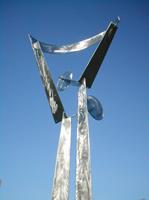
Bryn Mawr College

 |
Center Bryn Mawr College | 
|
December 11
Paul Grobstein (Biology, Center for Science in
Society)
Paul demonstrated this last claim by inviting us to share the experience of perceiving a blindspot. Where the optic nerve (the only mechanism of communication between the eye and brain) leaves the eye, the retina has a hole in it, a spot where it receives no information. And yet our brains are continuously and "seriously faking it," by reporting something (using the "fill-in command") at that location. (The "blacking out" and/or bright lights which occur with migraine headaches are other examples of this phenomena: pathological interruptions that show a normal neurological function.) A significant fraction (most?) of what we see is made up in our brains, and we "don't know" that this is happening, are not aware of it.
Moreover, our brains are bipartite. One part receives sensorial imput and paints a picture; the other sees (or interprets) it, without knowing how it was formed. Each of us has pictures in our heads that are painted by techniques we are unaware of. We collect information from our sensory pathways in the part of our brain we call the unconscious, which presents it to another part of the brain (which Paul calls "the I-function"). What goes on in "one box" is not known in the other one. The two parts of brain process information in different ways; painting and storytelling are ways of describing that process, but are not governing metaphors; another way of describing them might be as administrative and assembling functions, with the picture/story coming out of interactions between the two. This division of labor is really collaborative.
However, since all the information we receive from the outside world is approximate, indirect and subject to challenge, mitigated by processes that don't allow full disclosure, we cannot know what reality really is--and there are several ways of analyzing it. In processing sensory imput, it is possible to make up a number of different stories or paintings; there is no one-to-one correspondence between the information we are receiving and the account we are making of it. (Paul prefers not to use the word "perception" here, because it can mean both receptivity and interpretation, and so confuses the description of the process.)
Are we all then having the same internal experience?
Science does not need a concept of a physical reality; all it needs are imput signals to conduct its business of making stories--challengable axioms--that are constrained only by sensory imput it receives. The only distinctive thing about science is its requirement that every story be checked against imput signals. The echo location of bats is an example of what science is all about: a simple summary of observations which either work (i.e. are productive of new descriptions) or need improvement.
This "loopy" process occurs on two levels: there is the loop between output and imput--the need to check our models against the "report" of external reality--but there is also a loop within the brain, an internal loop from the unconscious to the I-function. The former represents information "metonymously" (thinking in terms of many variables and complicated relations), while the latter does so "metaphorically" (neatly, in simple relations); and information continuously travels back and forth between the two systems. Metonyms are meaningful substitutions based on contiguity, and serve a productive cross-indexing function in our neurological storage system, which analysts (for instance) draw upon when they encourage their patients to free associate. But the metonymic landscape can also be described metaphorically. The work being done now in cognitive science, in mapping the metonymic landscape, is seeking the shape of the paths we take through it, the habits we have formed to transverse it. Can we learn to take different routes? Actually rearrange the landscape? Walk into the basement with the lights off, and learn to illuminate different items?
Moreover, this landscape is always changing. And our brain can create new things, new worlds; we can make up realities that are different from what is supplied by our sensory imputs.
The Brown Bags will resume in the Spring Semester at noon on Thursdays (note change of day of week); Al Albano will initate the series on January 30. We look forward to seeing you then and there.
Home
| Calendar | About
| Getting Involved
| Groups | Initiatives | Bryn Mawr Home | Serendip Home
Director: Liz McCormack -
emccorma@brynmawr.edu
| Faculty Steering Committee
| Secretary: Lisa Kolonay
© 1994-
, by Center for Science in Society, Bryn Mawr College and Serendip
Last Modified:
Wednesday, 02-May-2018 11:57:05 CDT